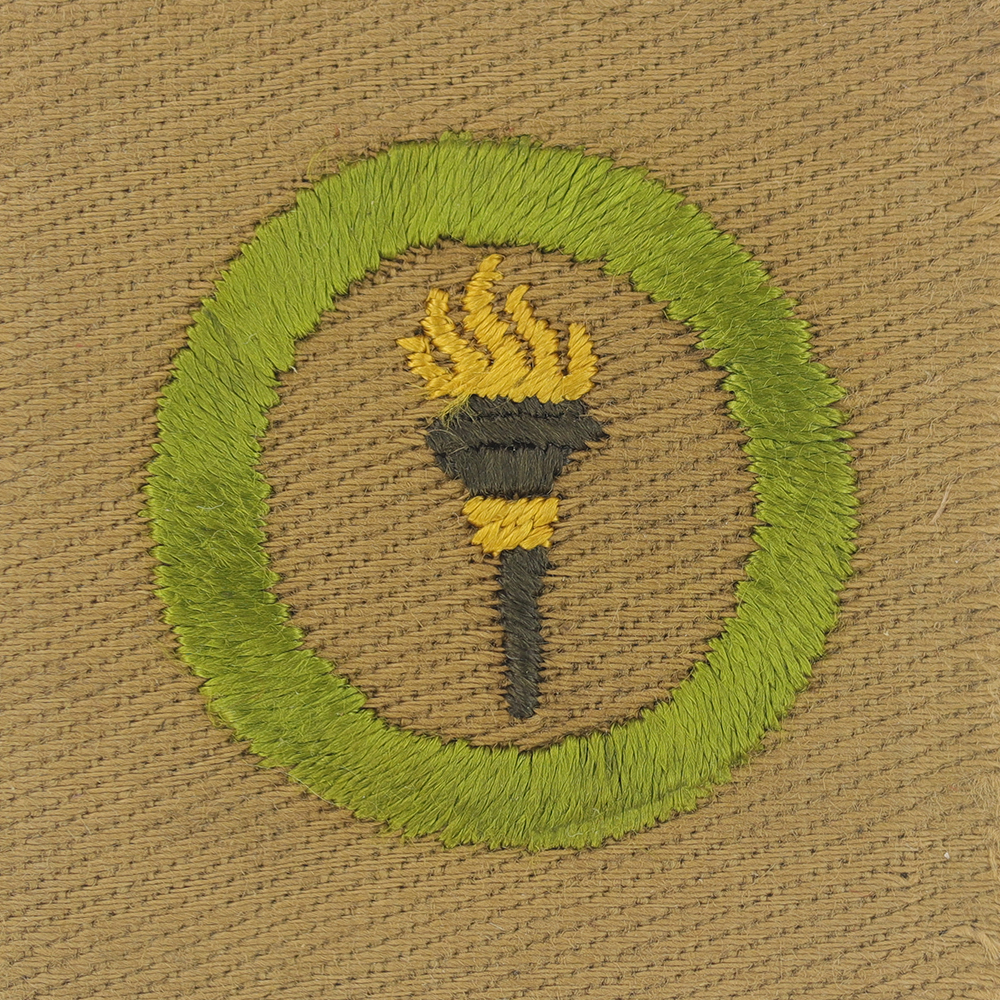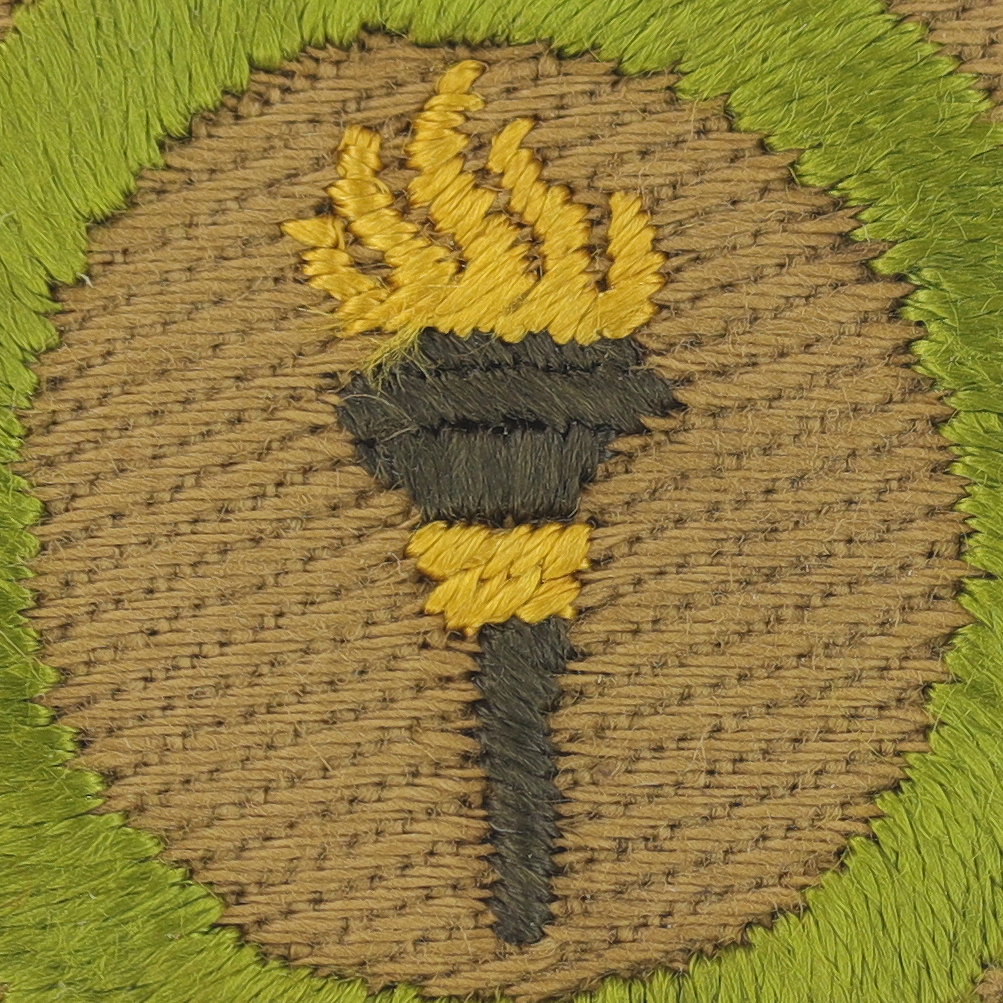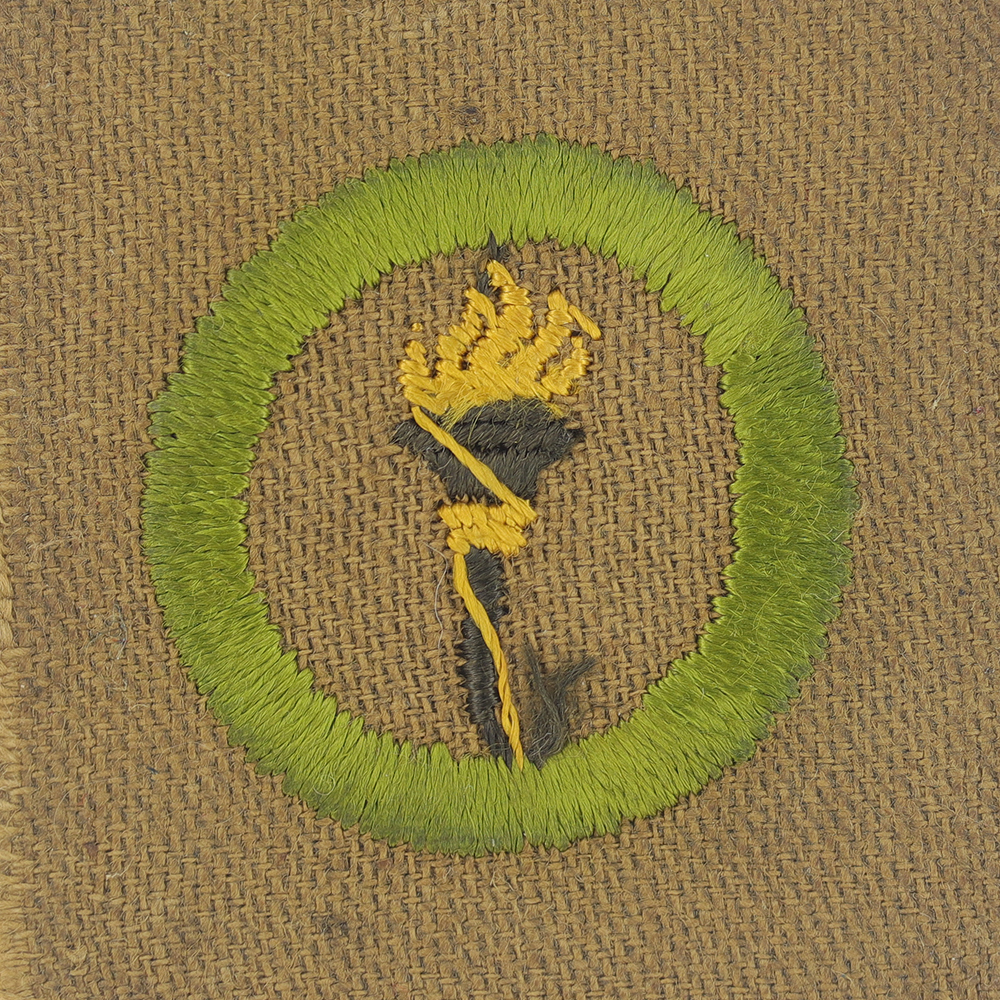
Fig. 1: PubHea-AD-Front

Fig. 2: PubHea-AD-Magnified

Fig. 3: PubHea-AD-Reverse
Item Name: Public Health 1933
Item ID: PubHea-AD
Collector Rating: 1
Additional Info:
- Fig. 1
- Cloth: Depression tan right twill
- Embroidery: Silk continuous
- Fig. 2:
- Design: Five well defined fingers of flame, thin handle, 2 gold bars
- Fig. 3:
- Back: Black imprint
Pamphlets Used to Earn this Badge
Requirements October 1914 until May 1923
1. State the chief causes and modes of transmission of each of the following diseases: tuberculosis, typhoid, malaria.
2. Draw a diagram showing how the house-fly carries disease.
3. Tell what should be done to a house which has been occupied by a person who has had a contagious disease.
4. Describe the method used in his community in disposing of garbage.
5. Tell how a city should protect its milk, meat, and exposed foods. State what are the laws in his community covering this subject, and to what extent they are being enforced.
6. Tell how to plan the sanitary care of a camp.
7. State the reason why school children should undergo a medical examination.
8. Tell how he may coöperate with the health authorities in preventing disease.
9. Produce satisfactory evidence that he has rendered service in some effort recommended by the public health authorities in the interest of Public Health.
Requirements May 1923 until July 1926
1. State the chief causes and modes of transmission of each of the following diseases: tuberculosis, typhoid, malaria, diphtheria, measles and scarlet fever.
2. Draw a diagram showing how the house-fly carries disease.
3. Tell what should be done to a house which has been occupied by a person who has had a contagious disease.
4. Describe the method used in his community in disposing of garbage and sewage and ensuring a pure water supply.
5. Tell how a city should protect its milk, meat, and exposed foods. State what are the laws in his community covering this subject, and to what extent they are being enforced.
6. Tell how to plan the sanitary care of a camp.
7. State the reason why school children should undergo a medical examination.
8. Tell how he may coöperate with the health authorities in preventing disease.
9. Produce satisfactory evidence that he has rendered service in some effort recommended by the public health authorities in the interest of Public Health.
Requirements July 1926 until April 1930
1. State the chief causes and modes of transmission of each of the following diseases: tuberculosis, typhoid, malaria, diphtheria, measles and scarlet fever.
2. Draw a diagram showing how the house-fly carries disease.
3. Tell what should be done to a house or room which has been occupied by a person who has had a contagious disease.
4. Describe the method used in his community in disposing of garbage and sewage and ensuring a pure water supply.
5. Tell how a city should protect its milk, meat, and exposed foods. State what are the laws in his community covering this subject, and to what extent they are being enforced.
6. Tell how to plan the sanitary care of a camp.
7. State the reason why school children should undergo a medical examination.
8. Tell how he may coöperate with the health authorities in preventing disease.
9. Produce satisfactory evidence that he has rendered service in some effort recommended by the public health authorities in the interest of Public Health.
Requirements March 1931 until June 1948
1. State the chief causes and modes of transmission of each of the following diseases: Tuberculosis, typhoid fever, diphtheria, malaria, hookworm disease.
2. Draw a diagram showing how the house-fly carries disease.
3. State the precautions which should be taken to prevent the spread of contagious disease during the sickness of the patient and following his removal or recovery.
4. Describe good methods by which a community may dispose of garbage and sewage, and may obtain a safe water supply, and tell what methods are used in his own community or on his own premises.
5. State the precautions which must be taken in producing and handling milk to make it as safe as possible from a health standpoint, and tell what the local laws require in this respect, and the extent to which they are enforced.
6. Tell how to plan and manage a small camp in a sanitary way.
7. State the reasons why school children should undergo a medical examination.
8. Tell how he may cooperate with the health authorities in preventing disease.
9. Describe different ways in which a person may become immune to infectious diseases.
10. Produce satisfactory evidence that he has rendered service in some effort recommended by the public health authorities in the interest of public health.

